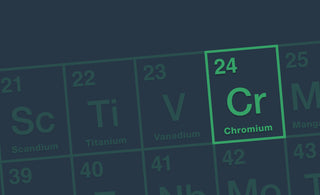
Does BOROUX filter chromium?
Yes, BOROUX filters chromium. See the test results!
Chromium is infamous due to its prevalence in southern California and the story about Erin Brockovich exposing the dangers of chromium in the drinking water. Chromium is a transition metal and when consumed in excess, can cause adverse health effects. Filtering it from tap water has immense benefits.
What is Chromium?
The metallic element, chromium, is naturally found in rocks, animals, plants, soil, and volcanic dust and gases. Chromium most often occurs as a compound when it bonds with other elements. It is commonly used to harden steel, to manufacture stainless steel and to produce alloys. Chromium alloys are used for oil tubing, automobile trim, and cutlery. Chromium is also present in many foods, such as meats, grain products, fruits, vegetables, nuts, spices, brewer’s yeast, beer, and wine. It is an essential trace element for humans because it helps process glucose. The amount of chromium in these foods varies greatly due to local soil and water conditions.
Chromium is a transition metal, meaning it forms positive ions for metallic bonds, and it has valence electrons. Metals are are usually have a silvery shine, are solid (except for mercury), they are malleable and they conduct electricity and heat. Valence electrons can form chemical bonds in two shells instead of only one. This is how we get the chromium compounds, trivalent (aka chromium 3) and hexavalent (aka chromium 6) chromium.
Chromium 6, often referred to as hexavalent chromium, is a heavy metal compound. It is concerning due to its potential health risks. It gained significant notoriety and public attention due to several high-profile events and its portrayal in the media. Specifically, the notoriety of chromium 6 escalated with the case made famous by Erin Brockovich, a legal clerk and environmental activist. Her work was popularized through the 2004 movie "Erin Brockovich," starring Julia Roberts. The film brought the issue to a wider audience, leading to increased awareness of chromium 6 contamination and its health implications.
Trivalent chromium, also known as chromium 3, it is a compound of the element chromium. It's more stable than the hexavalent chromium compound. It is an essential trace element in humans but chronic exposure may be harmful. Anything more than about one milligram a day is more than what's needed. Trivalent chromium is different from hexavalent chromium depending on what the element, chromium, bonds to.
Why Should Chromium Be Filtered?
Exposure to chromium has been linked to various adverse health effects, the most concerning being its potential to increase the risk of certain cancers, notably lung cancer. Chronic exposure to elevated levels of chromium can lead to respiratory problems, skin irritation, liver and kidney damage, and reproductive issues. Ingestion of water contaminated with chromium can cause gastrointestinal discomfort and weaken the immune system, making individuals more susceptible to illnesses.
Health Risks
- Cancer Risk: Prolonged exposure to chromium 6 has been associated with an increased risk of certain cancers, particularly lung cancer.
- Respiratory Problems: Inhalation of chromium 6 through aerosols or vapor can lead to respiratory issues, including asthma and chronic bronchitis.
- Skin Irritation: Direct contact with chromium 6-contaminated water may result in skin irritation and rashes.
- Liver and Kidney Damage: Chronic exposure to chromium 6 may harm the liver and kidneys, potentially leading to dysfunction and long-term health problems.
How Chromium Gets into Tap Water
Chromium can enter tap water through various sources, including industrial discharges, corrosion of plumbing materials (especially in older homes), and contamination from industrial sites. Most commonly chromium gets into the environment through ferrochrome production, followed by ore refining, chemical and refractory processing, cement-producing plants, automobile brake lining and catalytic converters for automobiles, leather tanneries, and chrome pigments. Individuals living nearby chromium waste disposal sites or chromium manufacturing and processing plants are at greater risk of excessive chromium exposure. Chromium occurs naturally in the earth's crust, and compounds are used for industrial purposes, both contribute to chromium's presence in water.
How BOROUX Filters Chromium
BOROUX water filtration systems are designed to effectively remove chromium from tap water, providing consumers with safer and cleaner drinking water. The filtration process involves several stages, ensuring comprehensive removal of chromium contaminants:
Activated Carbon Filtration: BOROUX filters use activated carbon, a highly porous material with a large surface area, which effectively adsorbs chromium, trapping it and preventing its passage through the filter.
Ion Exchange: BOROUX filters incorporate ion exchange resins, which attract and remove chromium ions from the water, exchanging them with harmless ions. This process enhances the filtration and purification of the water.
Mechanical Filtration: BOROUX filtration systems employ mechanical filtration mechanisms to physically strain out chromium particles, further enhancing the removal of these contaminants.
Chemical Adsorption: Specific chemical adsorbents within BOROUX filters selectively target chromium, adsorbing it and providing an additional layer of filtration for the water.
Testing at Different pH Levels
BOROUX foundation filters were rigorously tested for both hexavalent chromium and trivalent chromium, and to be more thorough, both were tested a different pH levels. Some elements, mostly metals, can be harder or easier to filter at different pH levels. The NSF/ANSI (National Sanitation Foundation/American National Standards Institute) standard tests at 6.5 pH and 8.5 pH, which covers almost all municipal tap water in the US.
For chromium reduction NSF testing, the filter is exposed to water containing chromium at specific concentrations (300 ug/L). Then, it is operated under controlled conditions to simulate real-world usage. During the testing period, samples of treated water are collected at regular intervals (50 gallons) to measure the concentration of chromium remaining in the water after passing through the filter. This determine the filter's effectiveness in reducing chromium levels to below the maximum allowable concentration (100 ug/L) specified by the standard. After 700 gallons, BOROUX foundation filters reduced chromium-6 to 42 ug/L when at a pH level of 6.5, and to 52 ug/L when at 8.5 pH. Chromium-3 when tested at 6.5 pH and 8.5 pH was reduced to 29 ug/L and 20 ug/L respectively. See test results.
In conclusion, BOROUX water filtration systems are equipped to effectively filter chromium from tap water, mitigating the potential health risks associated with its consumption. The combination of multiple filtration techniques ensures thorough reduction of chromium contaminants, providing consumers with peace of mind and access to quality drinking water. Investing in a reliable filtration system like BOROUX is a crucial step toward safeguarding one's health and well-being by reducing exposure to harmful chromium in tap water.
References:
Environmental Protection Agency. (April 1992, updated in January 2000). Chromium Compounds. EPA. https://www.epa.gov/sites/default/files/2016-09/documents/chromium-compounds.pdf
Difference Between. ( August 6, 2019). Difference Between Chromium and Hexavalent Chromium. Madhu. https://www.differencebetween.com/difference-between-chromium-and-hexavalent-chromium/



